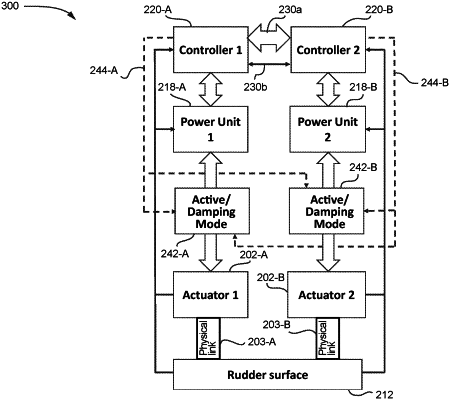| CPC B64C 13/503 (2013.01) [B64C 13/04 (2013.01); B64C 13/505 (2018.01)] | 22 Claims |

|
1. A dual channel rudder system architecture comprising:
first and second electronic controllers configured to provide rudder control with plural channel redundancy to first and second corresponding independently-controllable electromechanical actuators for rudder control, the first and second electronic controllers respectively interfacing signals to the first and second electromechanical actuators with independent control signals;
cross-channel intercommunication connections between the first and second electronic controllers, the cross-channel intercommunication connections including a redundant data communication bus and/or usage of discrete communications configured to coordinate dynamic operation of system discrete communications introducing a dissimilar method for a channel in control dynamic coordination; and
a distribution of aircraft and cockpit sensors through the first and second electronic controllers to meet minimum required safety standards in case of loss of input data;
the first and second electromechanical actuators each independently driving a common rudder control surface arranged in independent and redundant load paths,
at least the first electromechanical actuator connected to selectively alternately operate in a drive mode and a damping mode, in the drive mode the first electromechanical actuator being supplied with electrical current to drive the rudder to a position the first electronic controller specifies, in the damping mode the first electromechanical actuator providing back electromotive force (EMF) to dampen movement of the common rudder control surface imparted by wind gusts, thereby making an additional wind gust locking or damping device external to the first and second actuators unnecessary.
|